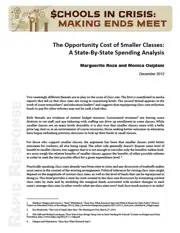Constrained revenues are forcing some districts to cut staff, which can drive up class sizes. While media reports tell us class sizes are rising to concerning levels, some researchers and education leaders suggest that repurposing class-size reduction funds to pay for other reforms may not be such a bad idea.
Consideration of whether smaller classes are preferable to larger ones requires some recognition of the opportunity costs involved. While smaller classes are on many levels desirable, they come with a hefty price tag. And so, in an environment of scarce resources, those seeking better outcomes in education have begun rethinking previous decisions to lock up their funds in small classes.
Practically speaking, class sizes vary from state to state, and any discussion of tradeoffs makes most sense in the context of the existing arrangement. Political tolerance for raising class sizes might depend on the magnitude of current class sizes, as well as the level of funds that can be repurposed in doing so.
This brief provides a state-by-state context by computing the dollars at stake in marginally raising the number of students per class. The study is a departure from other recent studies in that it computes cost implications by modeling a change to class-size data, in contrast to other analyses that model changes in pupil-teacher ratios.





